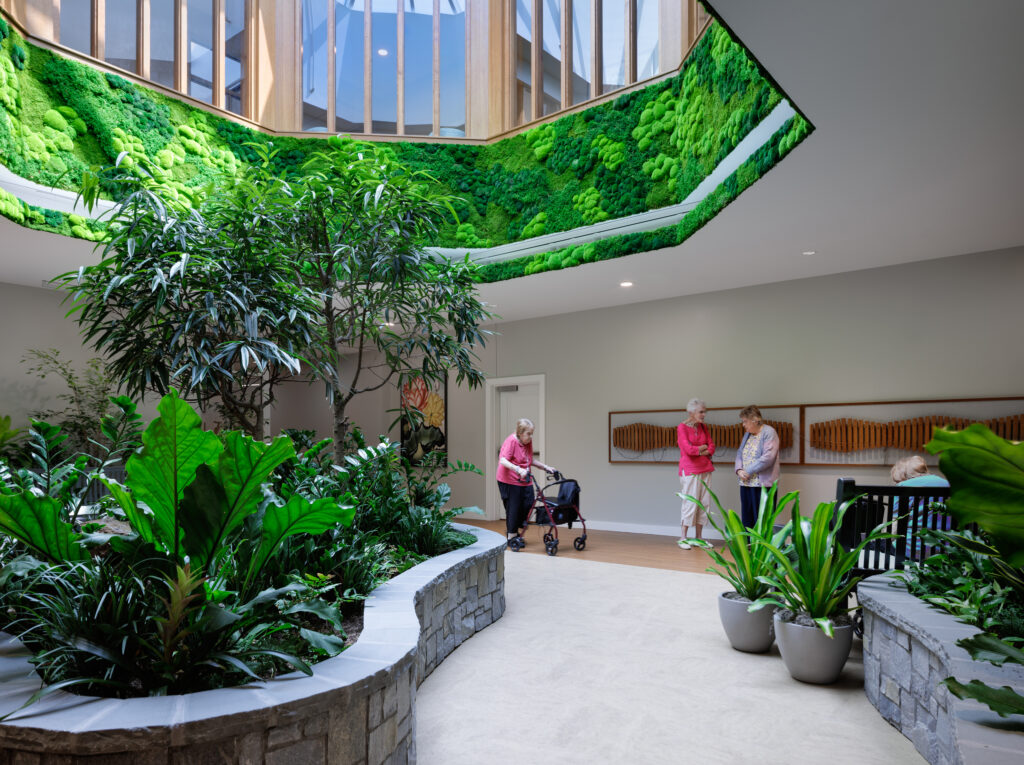How Senior Care Communities Can Keep Residents Connected with Nature
In our previous article, we highlighted a study that reveals that nature may have a significant impact on overall and mental health for seniors. We also shared some expert tips on how senior care communities can incorporate nature through their programming. Today, we’re pleased to be able to share advice on how senior care communities can use structural design elements to incorporate nature both outside and inside the buildings.
Incorporating Nature When Building a New Senior Care Community
Anthony Vivirito, LEED AP, associate with The Architectural Team, explains that there are numerous ways to incorporate nature during the planning and construction phases of a new community, but it all starts with a building’s location. He considers the building’s location, its solar orientation, its proximity to green areas, and the natural landscaping. “Often, the sites we get are either urban or suburban, so we’re looking for those types of design opportunities to adjust the building footprint, or to adjust the circulation to take advantage of natural landscaping that may be there,” he says. “If it’s not there, then we have the task of creating those natural elements.”

Image copyright Ed Wonsek. Used with permission
Vivirito notes that natural light is the driving force behind designing a building’s interior. “We’re looking to bring in as much natural light as we can,” he says. “A lot of the resident life is spent in common areas, and those are generally easiest to daylight because they’re along an exterior wall.” However, lighting becomes more challenging in residential corridors, since the corridors themselves are often artificially lit.
In designing The Cordwainer, a memory care community in Norwell, Massachusetts, Vivirito and his team were able to creatively incorporate natural light. “We created a light column or atrium with a living garden in this two-story building at the lowest level, then a lighted outlook on the second floor,” he explains. A 19×19-foot skylight at the top brought in natural light. “Bringing daylight into the core of the building was very effective,” he remarks.
Incorporating Nature for Residents with Limited Mobility
Residents who have limited mobility can benefit from spaces that are inside the building, as well as spaces outside the building located in close proximity to active zones. “Almost always we design a courtyard exterior at grade to provide for that mobility aspect,” says Vivirito.
Creating spaces around the building is also tremendously important to creating a connection to the outdoors. “You need to have access to those spaces,” he says. “In cold climates, six months of the year people aren’t going outside as much, but we provide common areas adjacent to those spaces so people can look out.”
Tips for Incorporating Interior Plant Installations

Image copyright Ed Wonsek. Used with permission
A highlight of The Cordwainer is that it incorporates an interior living garden, including a living tree, as well as living moss walls. Such interior plant installations can provide a way for residents to interact with nature; Vivirito explains that The Cordwainer installation is at an accessible height, so residents can garden in some of the beds. “It’s a captivating space to be in,” he says. “For most facilities an interior courtyard is a luxury, and you often see artificial plants. Here you have the small of the soil and the plants.”
Vivirito notes that when creating an interior plant installation, it’s essential to avoid selecting poisonous plants, especially in memory care settings. “That includes an outdoor courtyard as well,” he says. “Pick plants that are safe for humans.” Many landscape architects also choose plants that have a scent, since it can rekindle memories. “Lavender or other types of herbaceous plantings will evoke memories of things,” he says. Adding birdhouses to outdoor gardens can add visual interest and activity.
When implementing an indoor garden, Vivirito works with a specialty subcontractor who coordinates the depth of tree root balls to ensure that a tree has room to grow. Watering systems can be integrated, and a vendor is contracted to periodically monitor the health and condition of the plants. Communities can also decide to invest in more sophisticated irrigation systems that require less care.
Strategies to Incorporate Nature Into Existing Buildings

Image copyright Ed Wonsek. Used with permission
Vivirito often sees skilled nursing facilities transitioning into assisted living, and looking for a less institutionalized design. In studying the buildings, his team often chooses to demolish certain elements to create a visual or physical connection. “In existing buildings, that’s often an addition you need to add, or you would look to modify the landscape for an outdoor courtyard to create a comfortable outdoor space,” he says.
There are also many finishes available that can be used to create more natural touches, such as wallpaper that simulates floral patterns. “There are tones, materials, and products that are within most program budgets to play up a naturalistic theme,” he says. “Under the eye of a good interior designer, you can create these indoor-outdoor relationships in a creative, sometimes spontaneous way.”
Challenges of Incorporating Nature Into Design
Every project has its own unique challenges, but Vivirito finds that cost is often the most common challenge. “Creating outdoor amenities can get very expensive,” he says, “and there are structural considerations depending on how large the areas are.” Since these more natural areas are often passive in nature, communities may opt to use the funds on elements that receive more active use.
However, given our increased understanding of how staying connected with nature can impact senior health, it may make sense to prioritize these design elements even more. Doing so just might pay off with increased resident physical and mental wellness.

Paige Cerulli is a contributing writer to i Advance Senior Care.
Related Articles
Topics: Design , Featured Articles , Housing , Senior Environments











